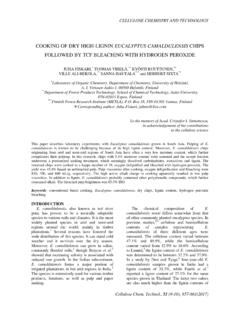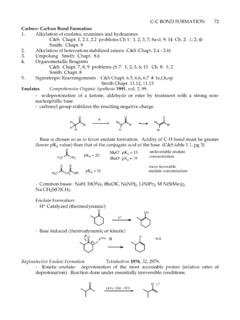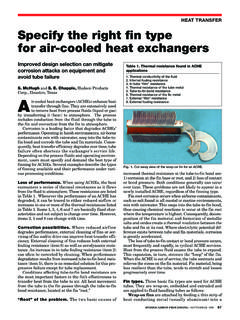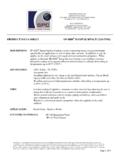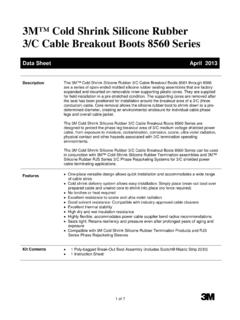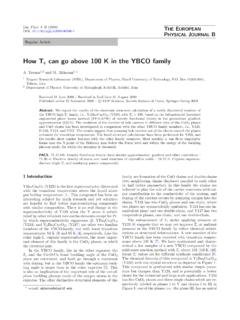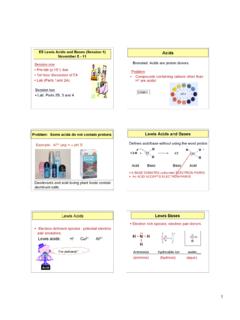Transcription of THERMAL DEGRADATION OF LIGNIN – A REVIEW
1 CELLULOSE CHEMISTRY AND TECHNOLOGY353. THERMAL DEGRADATION OF LIGNIN A REVIEW . MIHAI BREBU and CORNELIA VASILE. Petru Poni Institute of Macromolecular Chemistry, 41A, Gr. Ghica Voda Alley, 700487 Iasi, Romania Received November 26, 2009. The REVIEW describes recent knowledge acquired in the THERMAL DEGRADATION of LIGNIN as an approach to obtaining valuable chemicals or hydrocarbon fuel. Information on the temperature range, kinetics and mechanism of THERMAL DEGRADATION , as well as on the type of DEGRADATION products and on the methods proposed to obtain valuable chemicals is presented. Keywords: LIGNIN , biomass, pyrolysis, chemicals, fuels INTRODUCTION. LIGNIN , a valuable resource for chemicals Many studies were carried out on and energy, is a main component of wood, pyrolysis of LIGNIN alone or on co-pyrolysis together with cellulose and hemicellulose.
2 It of LIGNIN with other materials, such as is the second large source of organic raw synthetic polymers,8-12 aiming at determining material,1 constituting about 4-35 wt% of the temperature range and at developing most biomass, 16-25 wt% of hardwoods and kinetic models of Due to 23-35 wt% of As the most its complex composition and structure, the abundant natural aromatic polymer,3 LIGNIN DEGRADATION of LIGNIN is strongly influenced20. has a highly branched three-dimensional by its nature, reaction temperature, heating phenolic structure including three main rate and DEGRADATION atmosphere, which also phenylpropane units, namely p-coumaril, affects the temperature domain of coniferyl and sinapyl (Fig. 1). Softwood DEGRADATION , conversion and product yields LIGNIN contains relatively fewer sinapyl units (Fig. 2). and consists mainly of guaiacyl structures, LIGNIN decomposes slower, over a while hardwood LIGNIN contains guaiacyl- broader temperature range (200-500 C) than syringyl structures.
3 Cellulose and the hemicellulose components As a by-product of the paper industry, of biomass (Fig. 3). DEGRADATION studies LIGNIN is most often used by paper mills as a performed on different types of LIGNIN by fuel for the recovery of its energy content. THERMAL analysis (DTA) showed22-25 an However, due to the very large generated endothermic peak at 100-180 C, quantities, LIGNIN is increasingly considered corresponding to the elimination of humidity, as a potential source of chemicals, and followed by two broad exothermal peaks, the studies on its THERMAL DEGRADATION receive first one from 280 to 390 C and the second much interest. Pyrolytic LIGNIN , the organic one at higher temperatures, with a peak phase obtained from the pyrolysis of wood or around 420 C and a long tail beyond 500. of other biomass resources, consists of a C.
4 The DTG curves of LIGNIN decomposition brown tar containing high molecular weight show wide and flat peaks with a gently compounds derived from LIGNIN , while the sloping baseline26 that makes it impossible to water-soluble fraction, accounting for 60-70 define an activation energy for the wt% of the whole oil, contains lower This is different for the sharper molecular weight DTG peaks of cellulose and hemicellulose, inducing a flat tailing section at higher Temperature range and kinetics of LIGNIN temperatures for wood decomposition. THERMAL decomposition Heated up by 10 C/min, LIGNIN decomposes A strong interest has been manifested in very slowly (< wt%/ C), losing only 40. the analytical characterisation of LIGNIN , for wt% of its initial mass below 700 C. The determining its THERMAL ,7. DEGRADATION rate slightly increases30 to Cellulose Chem.
5 Technol., 44 (9), 353-363 (2010). MIHAI BREBU and CORNELIA VASILE. wt%/ C above 750 C, the mass loss at 850 mass transfer processes, which significantly C being of ~67 wt%. THERMAL DEGRADATION affect the activation energy of the process of LIGNIN is generally influenced by heat and and the pre-exponential factor. Figure 1: Partial structure of hardwood lignin4. (a) (b). Figure 2: DTG curves of LIGNIN from woody plants (a) and from annual fibre crops (b)21. 354. LIGNIN DEGRADATION Figure 3: Pyrolysis curves of three biomass components30. The kinetic studies on LIGNIN provided in LIGNIN , the Kraft LIGNIN gave more gases, and literature are based on various decomposition a higher synthetic gas (H2+CO) content, of Usually, LIGNIN decompo- 68 mol%. Other gases were CO2, CH4, C2H4. sition36,37 is assumed to occur by a single and The alkali LIGNIN studied under reaction of the first order, with the activation similar conditions produced45 in addition energy varying from to kJ/mol H2O, CH3OH and CH3 COCH3.
6 Over a temperature range of 244-309 C, and increasing to kJ/mol, with a frequency Mechanisms of LIGNIN THERMAL factor of x 10-5 min-1, over the 327-1167 decomposition C temperature LIGNIN LIGNIN thermally decomposes over a decomposition in microwave over a 160-680 broad temperature range, because various C temperature range was reported39 to have oxygen functional groups from its structure an activation energy of kJ/mol and a have different THERMAL stabilities, their frequency factor of x 10-2 min-1. scission occurring at different temperatures A more complex kinetic model, assuming (Scheme 1). The cleavage of the functional that LIGNIN is formed by fractions that groups gives low molecular weight products, decompose only above characteristic while the complete rearrangement of the temperatures, was proposed by Caballero et backbone at higher temperatures leads to 30- al.
7 ,40,41 giving a linearly increasing activation 50 wt% char and to the release of volatile energy from to 174 kJ/mol over the products. The cleavage of the aryl ether 200-600 C temperature range. TG and DSC linkages results in the formation of highly studies of Varhegyi et al. considered reactive and unstable free radicals that may complex networks of parallel, successive and further react through rearrangement, electron competitive reactions of pseudo-first order, abstraction or radical radical interactions, to leading to extremely low activation energies, form products with increased of 34-65 kJ/mol, and a pre-exponential factor Self-condensation by simple coupling of of for the decomposition of a series intermediates leads to an initial increase in of milled wood Kinetic studies on the molecular mass of the reaction products, the pyrolysis of Alcell and Kraft lignins over with a gradual approach to an equilibrium a 170-630 C temperature range, in a fixed- distribution.
8 Some LIGNIN -derived fragments bed reactor, showed lower activation have molecular weights in the 5000 amu energies, of 23-79 kJ/mol and of 17-89 range,4 the presence of phenol inhibits self- kJ/mol, respectively, which are probably due condensation, thus affecting the molecular to a significant mass and heat transfer mass distribution of the products in an Activation energies of 129-361 and equilibrium The differences in wood 80-158 kJ/mol, with a frequency factor of species mainly result in different DEGRADATION x x 1022 and x x 109 were rates for LIGNIN , as well as for the early stages reported for the decomposition of Alcell and of hemicellulose DEGRADATION . Coniferous Kraft LIGNIN , respectively, at heating rates LIGNIN is thermally more stable than from 5 to 15 C/min and final decomposition deciduous LIGNIN , the latter producing smaller temperature of 800 C.
9 A high heating rate char (15 C/min) increased conversion to 57 and Even small amounts of inorganic salts, 65 wt%, for both Alcell and Kraft LIGNIN . such as diammonium phosphate, largely used Having a higher H/C ratio than the Alcell as a flame retardant for wood, change the 355. MIHAI BREBU and CORNELIA VASILE. distribution of guaiacols from LIGNIN and Ca2+ strongly affect LIGNIN decomposition decomposition and act as catalysts for the ( Na+ enhances the charring reaction and scission of the main functional ,50 the formation of gaseous products).54-56. LIGNIN itself could be used51 as a flame- retardant for isotactic PP, both alone and in Products of LIGNIN THERMAL DEGRADATION synergism with some phosphate compounds The decomposition of the polymer and Al(OH)3. High and very high salt structure in LIGNIN starts at relatively low concentrations (up to 10-20 wt%, commonly temperatures, of 200-275 C, the main used for flame-retardancy) enhance the process occurring around 400 C, with the dehydration reactions, leaving high amounts formation of aromatic hydrocarbons, of char, whose condensed structures are not phenolics, hydroxyphenolics and guaiacyl- further degraded into low volatile /syringyl-type compounds, most products ,53 Cations such as Na+, NH+ having phenolic OH ,58.
10 Scheme 1: LIGNIN DEGRADATION by two competitive reaction pathways34. Table 1. Product yields from aged lime wood pyrolysis59. Wood age Carbohydrate LIGNIN DEGRADATION Composition of ligninsa (%). (years) DEGRADATION products (%) products (%) S Sb G Gc S/G. 6 150 180 180 (insects) 270 a S: syringyl-type compounds; G: guaiacyl-type compounds b Corrected S value = -59 + c Corrected G value = + The distribution and yields of products This was confirmed by are not significantly affected by the heating stepwise laboratory batch vacuum pyrolysis, conditions, being nevertheless strongly showing that guaiacol derivatives are dependent on the wood category, age and formed at lower temperatures, in condition (Table 1). Softwood lignins give methylguaiacol, ethylguaiacol, guaiacol mainly guaiacols, while hardwood lignins order, while syringol derivatives, phenol and give both guaiacols and syringols.


